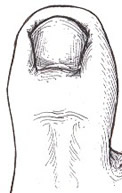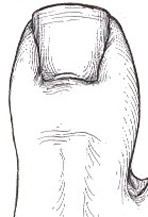WHAT IS AN INGROWN TOENAIL?
An ingrown toenail occurs when a section of the nail curves into the flesh of the toe and becomes embedded in the soft tissue. It can occur on any toe, but almost always affects the big toe. Sometimes callused or red granulation tissue (“proud flesh”) grows over the embedded edge. Secondary infection can occur, causing the skin at the side or tip of the nail to become red, swollen and tender. Sometimes, a small amount of pus can be seen draining from the inflamed area. This type of infection is called a paronychia.
WHAT CAUSES IT?
While several things can cause ingrown toenails, two major preventable causes are poorly fitting shoes and improperly trimmed nails. Shoes that are too tight press the sides of the nail and encourage it to curl in. Nails that are trimmed down into the corners are more likely to become ingrown.
HOW IS IT TREATED?

Improperly trimmed nail
Mild cases with mild to moderate pain, little or no redness, and no drainage can be treated by soaking in warm, soapy water at least 3 or 4 times daily. The edge of the nail can be lifted and a small piece of cotton placed under it to protect the skin.
In more severe cases with marked redness and drainage, minor surgery to remove part, or all, of the nail may be necessary. The nail will gradually grow back over several months. If surgery is performed, you will need to avoid physically strenuous activities for two weeks post operatively. Antibiotics are sometimes prescribed.
If the ingrown nail persists or recurs, it may be necessary to permanently remove the nail and destroy the root so it does not grow back.
CAN IT BE PREVENTED?

Properly trimmed nail
Several steps can be taken to decrease the risk of developing ingrown toenails.
-
Cut nails straight across without tapering the corners, which should reach out from the toe, as shown in the illustration. This is probably the most important factor in preventing ingrown toenails.
-
Avoid wearing shoes and socks that are too tight.
-
Keep feet clean to prevent the ingrown nail from becoming infected.
References
- American Academy of Family Physicians (7/95).
- Hecht, A. (1985). Caring for corns, bunions and other agonies of de-feet. FDA Consumer, June, pp. 23-24.
- Larson, D. E. (Ed.). (1990). Mayo clinic family health book. New York: William Morrow and Company.
- Goldstein, B. G., & Goldstein, A. O. (2010, October 7). Paronychia and ingrown toenails.








